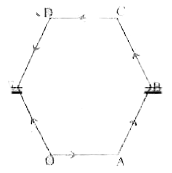Let the vectors →a,→b,→c be given as a1ˆi+a2ˆj+a3ˆk,b1ˆi+b2ˆj+b3ˆk, c1ˆi+(c2ˆj)+(c3ˆk).Then show tha→a×(→b+→c)=(→a×→b)+(→a×→c).Solution in Tamil
The correct Answer is:=→a×→b+→a×→c
Step by step video, text & image solution for Let the vectors veca, vecb, vec c be given as a_(1)hat i + a_(2)hatj + a_(3)hat k, b_(1)hat i + b_(2) hat j + b_(3) hat k, c_(1)hat i + (c_(2)hat j )+( c_(3)hat k).Then show thavec a xx(vec b + vec c) = (vec a xx vec b)+( vec a xx vec c). by Maths experts to help you in doubts & scoring excellent marks in Class 12 exams.
Updated on:21/07/2023Topper's Solved these Questions
- VECTOR ALGEBRABOOK - NEW JOYTHI PUBLICATIONCHAPTER - VECTOR ALGEBRAEXERCISE - ADDITIONAL QUESTIONS FOR PRACTICE 10.1
2 Videos
- VECTOR ALGEBRABOOK - NEW JOYTHI PUBLICATIONCHAPTER - VECTOR ALGEBRAEXERCISE - ADDITIONAL QUESTIONS FOR PRACTICE 10.2
13 Videos
- VECTOR ALGEBRABOOK - NEW JOYTHI PUBLICATIONCHAPTER - VECTOR ALGEBRAEXERCISE - SOLUTIONS TO NCERT TEXT BOOK EXERCISE 10.3
18 Videos
- TRIGONOMETRIC FUNCTIONSBOOK - NEW JOYTHI PUBLICATIONCHAPTER - TRIGONOMETRIC FUNCTIONSEXERCISE - QUESTIONS FROM COMPETITIVE EXAMS
134 Videos
Similar Questions
In the figure which vectors are
(i) equal (ii) collinear (iii) coinitial

View SolutionCompute the magnitude of the following vectors and identify the unit vector.
→a=2ˆi−3ˆj+5ˆk
View SolutionFind the angle between two vectors →a and →b with magnitudes √3 and 2, respectivey having →a.→b=√6.
View SolutionIf A+B+C=90∘ then
cotA+cotB+cotCcotAcotBcotC =
View SolutionLet the vectors →a,→b,→cbe given as a1ˆi+a2ˆj+a3ˆk,b1ˆi+b2ˆj+b3ˆk,c1ˆi+c2ˆj+c3ˆk. Then show that →a×(→b+→c)=→a×→b+→a×→c
View SolutionLet vec a = hat i + hat j + hat k, vec b = hat i + 4 hat j - hat k, vec c = hat i + hat j + 2 hat k and hat s be a the unit vector the magnitude of the vector (vec a .vec s)(vec b xx vec c) + (vec b. vec s)(vec c xx vec a) + ( vec c.vec s)(vec a xx vec b) is equal to (A) 1 (B) 2 (C) 3 (D) 4
View SolutionLet →a=ˆj−ˆk and →c=ˆi−ˆj−ˆk . Then vector →b satisfying →a×→b+→c=→0 and →a.→b=3 is (1) 2→i−→j+2→k (2) ˆi−ˆj−2ˆk (3) ˆi+j−2ˆk (4) −ˆi+ˆj−2ˆk
View SolutionLet vec b=3hat j+4hat k,vec a=hat i+hat j and let vec b_(1) and vec b_(2) be component of vector b parallel and perpendicular to vec a .If vec b_(1)=(3)/(2)hat i+(3)/(2)hat j then vec b_(2) is equal to
View SolutionLet →a=ˆi+ˆj+ˆk,→b=ˆi and ˆc=c1ˆi+c2ˆj+c3ˆk . Then, (1)If c1=1 and c2=2, find c3 which makes →a,→b and →c coplanar. (2)If c2=−1 and c3=1, show that no value of c1 can make →a,→b and →c coplanar.
View SolutionIf →a=a1ˆi+a2ˆj+a3ˆk;→b=b1ˆi+b2ˆj+b3ˆk,.→c=c1ˆi+c2ˆj+c3ˆk and [3→a+→b 3→b+→c 3→c+→a]=28[→a→b→c] , then find the value of λ4 .
View SolutionIf vec(a) = 3 hat(i) + 2 hat(k) , vec(b) = 3hat(j) - hat(k) and vec(c ) = hat(i) + hat(j) + hat(k) . Find ( vec(a) xx vec(b)). vec(c ) .
View SolutionTwo balls , having linear momenta vec(p)_(1) = p hat(i) and vec(p)_(2) = - p hat(i) , undergo a collision in free space. There is no external force acting on the balls. Let vec(p)_(1) and vec(p)_(2) , be their final momenta. The following option(s) is (are) NOT ALLOWED for any non -zero value of p , a_(1) , a_(2) , b_(1) , b_(2) , c_(1) and c_(2) (i) vec(p)_(1) = a_(1) hat(i) + b_(1) hat(j) + c_(1) hat(k) , vec(p)_(2) = a_(2) hat(i) + b_(2) hat(j) (ii) vec(p)_(1) = c_(1) vec(k) , vec(p)_(2) = c_(2) hat(k) (iii) vec(p)_(1) = a_(1) hat(i) + b_(1) hat(j) + c_(1) hat(k) ,vec(p)_(2) = a_(2) hat(i) + b_(2) hat(j) - c_(1) hat(k) (iv) vec(p)_(1) = a_(1) hat(i) + b_(1) hat(j) , vec(p)_(2) = a_(2) hat(i) + b_(1) hat(j)
View SolutionIf →a=a1ˆi+a2ˆj+a3ˆk,→b=b1ˆi+b2ˆj+b3ˆk and →c=c1ˆi+c2ˆj+c3ˆk prove that →a×(→b+→c)=→a×→b+→a×→c
View SolutionIf ˆi,ˆjandˆk are unit vectors along three mutuaaly perpendicular axes and →a=a1ˆi+a2ˆj+a3ˆk,→b=b1ˆi+b2ˆj+b3ˆkand→c=c1ˆi+c2ˆj+c3ˆk prove that
→a.(→b+→c)=→a.→b+→a.→c
View SolutionIf ˆi,ˆjandˆk are unit vectors along three mutuaaly perpendicular axes and →a=a1ˆi+a2ˆj+a3ˆk,→b=b1ˆi+b2ˆj+b3ˆkand→c=c1ˆi+c2ˆj+c3ˆk prove that
(→b+→c)×→a=→b×→a+→c×→a
View Solution
